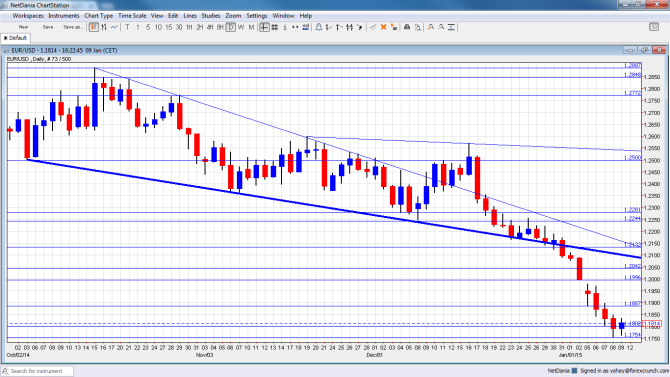EUR/USD continued the downfall into levels last seen in 2006 as 2015 came into full swing. Will we see a correction anytime soon? More inflation figures as well as the decision of the ECJ are among the big events of the week. Here is an outlook for the highlights of this week and an updated technical analysis for EUR/USD.
QE in the euro-zone seems imminent for the January 22nd meeting, after the euro-zone officially slipped into deflation. Oil prices were clearly to blame. Can the tick up in core prices help? Probably not. Worries about Greece and the tragic terror attack in Paris also weighed in, while the fall in German unemployment was shrugged off. In the US, things are looking OK, with 252K jobs gained in December, but the slip in wages is causing some worries.
[do action=”autoupdate” tag=”EURUSDUpdate”/]EUR/USD daily chart with support and resistance lines on it. Click to enlarge:
- German WPI: Tuesday, 7:00. The wholesale price index in Europe’s largest economy provides further insight about inflation in the old continent. A rise of 0.2% is expected after the slide of 0.7% beforehand.
- ECJ decision: Wednesday, during the European morning. The European Court of Justice received the case of the legality of the ECB’s actions from the German Constitutional Court. The wheels of justice move slowly: this case is related to the OMT, introduced in 2012 by the ECB and never used. However, the legality of buying sovereign bonds is more actual than ever, with the ECB on the brink of a QE program. The court is expected to approve the actions of the central bank, or more precisely, not intervene. The ruling still draws attention and volatility.
- French CPI: Wednesday, 7:45. Europe’s second largest economy experienced a fall of 0.2% in prices during November, and no change is expected for December. However, price drops could be seen in December due to oil prices. The French report feeds into the final euro-zone read later in the week.
- Industrial Production: Wednesday, 10:00. While we already have the German and French reports at this point, the full publication still rattles markets. Output grew by only 0.1% in October and a similar number is likely for November: no change is expected.
- Trade Balance: Thursday, 10:00. The euro-zone enjoys a surplus in its trade balance, and this keeps the euro bid. After experiencing a positive figure of 19.4 billion in October, and even wider surplus is on the cards for November: 21.3 billion.
- German Final CPI: Friday, 7:00. According to the initial publication, Germany saw a significant slowdown in year over year inflation in December: 0.1%. The lowest figure since 2009 will likely be confirmed in the final read.
- Final inflation numbers: Friday, 10:00. The initial read for the euro-zone was a big blow: a drop of 0.2% in prices year over year in December – an annual deflation in 2014. However, this fall was fueled by oil prices as core prices actually ticked up from 0.7% to 0.8%. Both numbers are expected to be confirmed.
* All times are GMT
EUR/USD Technical Analysis
Euro/dollar fell off the 1.20 cliff (mentioned last week) already in the first hours of the new trading week, and it was all downhill from there. The 2010 low of 1.1876 was taken relatively easily and the pair continued plunging. 1.1754 is the bottom so far, from where we saw a bounce.
Live chart of EUR/USD: [do action=”tradingviews” pair=”EURUSD” interval=”60″/]
Technical lines from top to bottom:
We start from lower ground now. 1.2280 provided support to the pair in December, but it isn’t a strong line. 1.2245 served as support several times in that summer, and 1.2170 was the “shoulder” in the inverse H&S pattern around the same time. It was also the low point in December 2014. The last line in the previous cycle is the 2012 low of 1.2040.
The very round number of 1.20 is still of very high importance. 1.1950 is where a recovery attempt was stopped in January 2015.
Below, the post crisis low of 1.1867, recorded should be watched. 1.1750 was a low point the pair reached during the recent avalanche. The round number of 1.17 was the launch value of the pair in 1999 and has a symbolic meaning.
If we take an even deeper dive, 1.1620 provides some support before the round number of 1.15.
Uptrend support broken
The line that provided support to the pair during October, November and December several times, is now broken after the last crash.
I turn from bearish to neutral on EUR/USD
Everything is going against the euro: worries about Greece, terror in France and most importantly for the euro: deflation and the consequent QE, which is looking very real. However, the pair fell very fast without any pause to breath. We could see some stabilization now, within the long term trend which remains down. The worries about wage growth in the US could add to some stability for EUR/USD for now, even if there are good reasons for wage hikes in January.
Further reading:
- For a broad view of all the week’s major events worldwide, read the USD outlook.
- For the Japanese yen, read the USD/JPY forecast.
- For GBP/USD (cable), look into the British Pound forecast.
- For the Australian dollar (Aussie), check out the AUD to USD forecast.
- USD/CAD (loonie), check out the Canadian dollar forecast
- For the kiwi, see the NZDUSD forecast.

